Jan Svoboda. Magnetic Techniques for the Treatment of Materials
Подождите немного. Документ загружается.

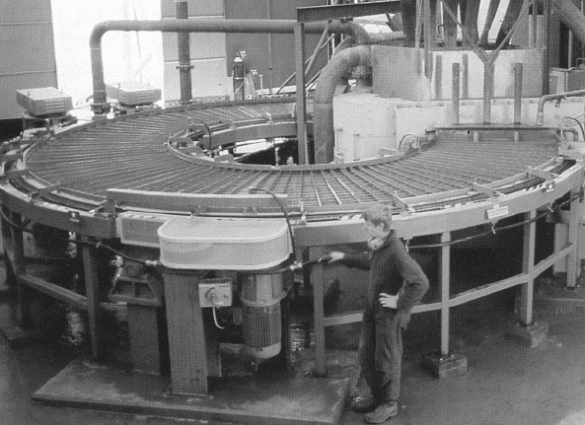
560 CHAPTER 7. INNOVATION AND FUTURE TRENDS
Figure 7.8: Sala-Metso Minerals HGMS carousel high-gradient magnetic sepa-
rator, model 480 (courtesy of Metso Minerals).
magnetic field is limited by the saturation magnetization of the yoke material
and the scale-up is di!cult. In order to treat a meaningful quantity of material,
the working gap between the poles of an electromagnet must be large, which
results in a significant drop in the magnetic field and the machine becomes
massive. To generate a su!ciently large magnetic field at large volumes, an
iron-clad solenoid must be used [M5], as has been discussed in Sections 2.4.3
and 4.4.
Sala HGMS While the design of a cyclic HGMS based on the iron-clad
solenoid is a straightforward process, continuous solenoid separators require a
more complex approach. Sala Magnetics, Inc. developed a carousel HGMS [O5]
that employed a sophisticated saddle-shaped iron-clad solenoid surrounding the
carousel ring. The separator shown in Figs. 2.64 to 2.67 and 7.8 can, in con-
trast to its predecessors, generate a background magnetic field as high as 2 T,
allows a close control of flow velocity through the matrix and can be relatively
easily scaled-up.
In spite of the obvious advantages of this second-generation HGMS, the Sala
separator did not enjoy commercial success at that time. Although the separa-
tor was earmarked for several large-scale applications, the cost was apparently
prohibitive and the market was reluctant to accept the product in spite of its
progressive features.
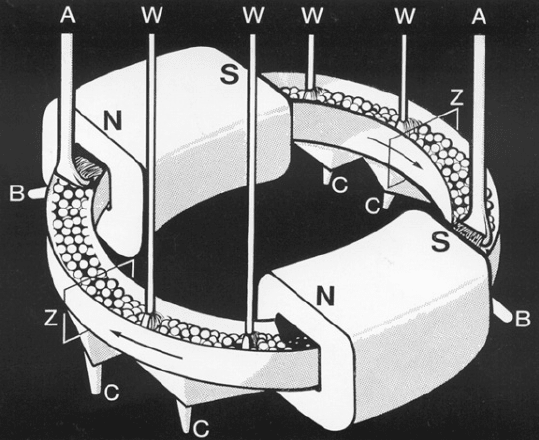
7.3. MAGNETIC SEPARATION AND INNOVATION 561
Figure 7.9: SOL high-gradient magnetic separator.
SOL HGMS In the SOL separator, designed and built by Krupp GmbH
[S99, S1], the saddle-shaped solenoid was replaced by a simple axially orientated
solenoid, as shown in Fig. 7.9. In order to provide a reasonably long retention
time of the slurry in the magnetic field, the magnet had to be su!ciently long.
The air gap of the magnet was, therefore, long and the magnetomotive force
needed to generate the required magnetic field was very high. Moreover, because
the coil was much longer that its diameter, the beneficial eect of the steel
cladding was negligible.
As a result of this misconceived approach to the magnet design, the SOL
separator could generate only a modest magnetic field at very high energy input
per tonne of treated material. For these reasons the separator failed to gain
acceptance by the industry.
VMS HGMS Probably the most onerous problem in the operation of HGMS
separators is a permanent retention of particles in the matrix. Frequent shut-
downs of the separators for cleaning or replacement of a blocked matrix severely
impair the economic and metallurgical performance of the units. Numerous pre-
ventive measures that were investigated and applied in practice [S1] were found
to be of interim e!cacy only. The long-term solution was oered by machines
that employed a back-flushing system.
The VMS magnetic separator developed by the Ore Research Institute,
Prague, Czech Republic [C7], addressed the problem of matrix clogging by re-
placing the conventional horizontal rotor by a vertically rotating ring, as shown
562 CHAPTER 7. INNOVATION AND FUTURE TRENDS
in Fig. 2.68. In addition to the reverse flush, the main advantages of the VMS
separators, which employ an iron-clad solenoid, are excellent ability of scale-up
and a high background magnetic field at modest input power.
The VMS separators were earmarked for incorporation into the Krivoy Rog
and Kursk Magnetic Anomaly iron ore beneficiation plants in the former USSR.
The proposed capacity of the plants was 30 Mt/a and it was envisaged that at
least forty VMS separators, each with a capacity of 100 t/h, would be required.
Numerous di!culties were experienced, associated mainly with the disinte-
gration of the Eastern Block in the late 1980s and early 1990s. In particular, the
completion costs escalated as a result of rampant inflation in the former USSR
during those transition years. In 1991 the Czechoslovak government decided to
pull out from this joint venture and write o US$300 million already invested in
the project. The beneficiation complex was never fully commissioned and po-
litical circumstances were, therefore, responsible for the failure of a promising
innovative technology to be implemented on production scale.
SLON HGMS In spite of its commercial misfortune, the concept of the VMS
separator proved beyond doubt that the use of an iron-clad solenoid and the ap-
plication of the reverse flush of the matrix enhances the e!ciency, scalability
and availability of continuous high-gradient magnetic separators. The techni-
cal success of VMS separators prompted further innovative eort. The SLON
HGMS developed at the Ganzhou Non-ferrous Metallurgy Research Institute,
Ganzhou, China, and shown in Fig. 2.74, is based on the VMS concept [X1].
In order to improve the e!ciency of separation even further, SLON employs
an iron-clad solenoid located in the bottom section of the vertical ring carrying
the matrix. This feature allows a pulsation of the slurry within the matrix to be
introduced, which results in better selectivity of separation. The separator that
is used, at the present time, to beneficiate weakly magnetic iron and ilmenite
ores enjoys considerable commercial success in China and is making inroads into
the international markets.
Magnetic separation and superconductivity
Superconductivity has been seen as a panacea in magnetic separation, partic-
ularly because of its ability to generate a magnetic field exceeding 2 T, the
maximum field that can be generated by most resistive electromagnets. Ad-
ditional advantages include low running costs, low mass and large volumes in
which the high magnetic field can be generated.
Although numerous small-scale superconducting magnets were built in the
late 1970s [S1], production-scale machines were slow to emerge. The first in-
dustrial superconducting separator was designed and built by the Institute for
Refrigeration Engineering (VUPCHT), Prague, Czech Republic [F6]. This 5 T
unit, shown in Fig. 2.83, was a reciprocating canister machine for beneficiation
of kaolin.
The design of the magnetic system, the choice of the operating magnetic field
strength and of the matrix were based on a theoretical description of particle
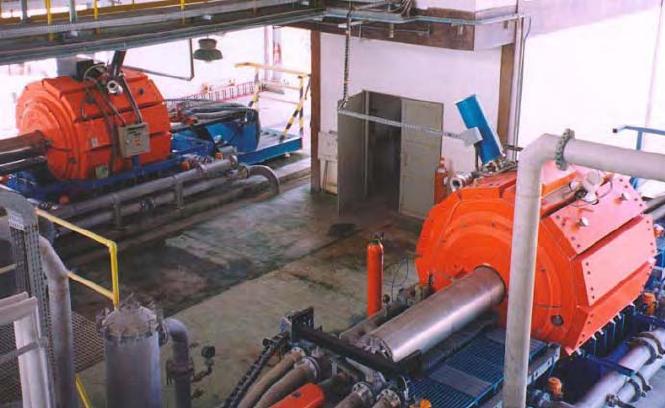
7.3. MAGNETIC SEPARATION AND INNOVATION 563
Figure 7.10: Installation of Cryofilter superconducting separators at Cadam,
Brazil (courtesy of Outokumpu Technology, Inc.).
capture by a single magnetized wire. Such theoretical models, very popular in
the late nineteen seventies and early eighties, failed to describe correctly the
dependence of particle capture on key operational parameters. This approach
sometimes resulted in costly and unnecessarily complicated design of magnetic
separators and the VUPCHT separator was no exception.
Initially, the performance of the VUPCHT separator was encouraging. How-
ever, the subsequent deterioration in e!ciency, and drop in throughput, as a
result of matrix blockage, led to closure of the plant. The fate of the VUPCHT
superconducting separator demonstrates how unproven academic reasoning and
erroneous interpretation of laboratory data, with limited relevance to practical
operation, can result in failure to implement a new technology.
Not surprisingly, the subsequent production-scale superconducting HGMS,
developed by Eriez Magnetics, Inc. and shown in Fig. 2.80, was based on a
conventional cyclic design [S16]. The magnet generated a 2 T magnetic field,
su!cient to treat most minerals. The fast-ramp magnet allowed the maximum
field to be reached in less than 60 s, which enabled a reasonable duty factor to
be obtained without resorting to a mechanically more complicated reciprocating
matrix system.
Further developments in superconducting technology and better understand-
ing of mechanisms of HGMS led to a revival of the reciprocating matrix concept.
After Carpco Inc. acquired, in 1991, the Magnetic Separation Group from Cryo-
genic Consultants Ltd., development of reciprocating canister superconducting
magnets gained momentum. Several types of separators of dierent sizes were
564 CHAPTER 7. INNOVATION AND FUTURE TRENDS
developed and installed at kaolin processing operations. The first large 5 T ma-
chine, with a diameter of the reciprocating tube of 500 mm and throughput of
up to 50 t/h was delivered in 1993 to Caulim di Amazonia (Cadam), a Brazilian
kaolin company. The machine requires 1000 litres of liquid helium per year,
which is transferred annually. No liquid nitrogen is required and a small re-
frigerator, running at 10 kW, provides cooling at an intermediate temperature
[W36]. The reduction in energy costs compared to conventional HGMS units
amounts to about 95%. Further installations, including the largest separator
of 1000 mm diameter, Cryofilter 5T/1000, under the Outokumpu Technology
label after Outokumpu acquired Carpco Inc. in 1998, took place in several other
kaolin operations. Figure 7.10 illustrates the two units delivered to Cadam.
Open-gradient magnetic separators
An unsuccessful attempt, potentially of breakthrough significance, to implement
an innovative technique was the application of open-gradient magnetic separa-
tion to beneficiate pyroxenite ore. OGMS, instead of employing a matrix to
generate a magnetic field gradient, uses the actual magnet windings to create
the field gradient and magnetic force that deflect magnetizable particles. A
schematic diagram of such a "falling curtain" superconducting OGMS is shown
in Fig. 2.85.
As has been discussed in Section 2.5.3, Cryogenic Consultants Ltd. built a
production-scale linear race-track magnet OGMS that was earmarked for the
dry concentration of apatite from phlogopite [R19]. The magnet suered from
repeated quenches resulting from electromagnetic stresses [K31]. In spite of
considerable expenses to resolve the problems and to salvage the project, the
separator was never commissioned. This case illustrates the consequences of an
attempt to introduce an immature technology into a production environment.
Separation in magnetic fluids
It has been discussed in Section 2.8.2 that AVCO Corp., NASA [M12], Hitachi
[N4] and other organizations successfully demonstrated, in 1970s, that it was
possible to achieve a very high selectivity of separation of non-ferrous metals
from automobile scrap in ferrofluids at industrially meaningful separation rates.
In spite of the positive outcomes of these campaigns, further production-scale
implementation of the FHS technique did not happen. It can be speculated that
the reason for non-acceptance of FHS by the market at that time was that the
need for scrap recycling was not yet well developed. The perceived high cost of
ferrofluid and the need to recycle it probably contributed to the fact that the
introduction of FHS to the metal recycling industry was not successful.
At a somewhat later stage, a wide range of ferrohydrostatic separators was
developed by the GMUO Institute in Lugansk, in the former USSR [G5]. The
application of these units included the density separation of coal and non-ferrous
metals and the recovery of diamonds, gold and other platinum-group metals.
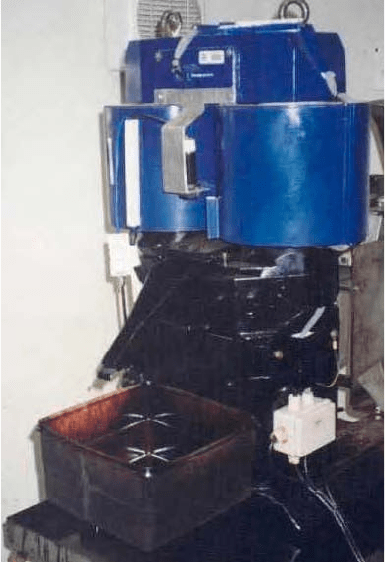
7.3. MAGNETIC SEPARATION AND INNOVATION 565
Figure 7.11: The GMUO ferrohydrostatic separator FHS-40M.
Figure 7.11 shows an FHS-40M ferrohydrostatic separator designed for the re-
covery of fine diamonds from the final sorting concentrate.
In 1992 six of the FHS separators that had been supplied to Yakutalmaz in
Yakutia, Russia, for the recovery of diamonds, underwent, successfully, detailed
acceptance tests and it was decided to install them in production at Yakutalmaz
to replace the toxic heavy liquid Clerici solution. It appears, however, that
this new technology was treated with suspicion by the workforce. FHS was
apparently seen as a threat to various benefits and perks. The management was
forced to abandon this novel technique.
More fortunate was the GMUO FHS separator for the recovery of gold from
placer gravity concentrates. It was reported that in 1993 this technology, which
eliminates the need to use mercury amalgamation, was operating in nine Russian
gold mining operations [S55]. Even more successful appears to be permanent
magnet-based Geos ferrohydrostatic separators. It was reported that in 1995
these systems were in operation in 19 gold-processing plants in Russia [S54].
It can be seen that separation in ferrofluids, in spite of a few patches of
misfortune, is on its way to successful implementation on production scale. The
existing applications are in areas where a high density dierence between the
566 CHAPTER 7. INNOVATION AND FUTURE TRENDS
fractions to be separated allows a low level of sophistication of the equipment.
Considerable progress has, however, been made in the development of selective
FHS separators with automated density control with the main emphasis on
application in the diamond-winning industry. Scale-up of the technology has
also been addressed, technology for the recovery and recycling of ferrofluid has
been developed, and low-cost ferrofluids are being produced on a production
scale [S23]
These recent developments in FHS and new waste legislation in various First
World countries open again the door for the application of FHS in the recycling
of metals and metallic products and the recovery of non-ferrous metals [S92].
Concluding summary
Our walk through the innovation landscape in magnetic separation illustrates
the enormous eort that was expended over the years in order to convert a wealth
of novel ideas into workable techniques and to introduce them into material
treatment operations. The cases discussed above illustrate that there have been
numerous successful innovations in magnetic separation. Permanent magnetic
roll separators, matrix separators as conceived by Jones, iron-clad solenoids as
aspin-o of a search for the elusive magnetic monopole by the MIT scientists,
the replacement of the Jones horizontal rotor in HGMS by a vertically rotating
ring carrying the matrix and the introduction of eddy current techniques to
the separation of non-ferrous metals are examples of the remarkable success of
innovation and technology transfer.
On the other hand, there is an equal share of unmistakable failures. The
reasons for these failures cover a wide spectrum of risks that accompany any
eort to implement new technology. The derailers that were responsible for the
failures in technology transfer can be identified from our analysis:
• The excessive cost of a product, in order to recover the research and devel-
opment costs in the shortest possible time, not compatible with the market
needs and with the availability of an alternative technique or product.
• Incorrect assessment of technical feasibility. A technique was not feasible
or viable from first principles and in spite of this, it was still developed
and oered to the industry.
• Political turmoil and changes on a regional level prevented implementation
of a novel and su!ciently mature technology. In spite of financial losses
and time delay, this setback became a basis for even further innovation.
• Premature application of unproven technology. Scale-up of the research
results was attempted with limited consideration of the production-scale
complexities.
• Poor engineering of an ambitious and complex technique.
• Insu!cient market need in relation to the complexity and cost of the
technique.
7.4. CURRENT STATUS OF MAGNETIC SEPARATION TECHNOLOG
Y
567
• Resistance to change from the workforce and fear of job and perk losses.
It is also interesting to note from the above analysis that the mining and
material-handling companies that were trying to introduce innovation in their
operations by implementing the magnetic separation technology usually did not
carry out the research and development in-house, but rather preferred to procure
proven, or seemingly proven, equipment or techniques. While this is a safe and
cheaper way of acquiring a novel technology, it also carries some risks. The user
becomes dependent on the supplier’s expertise, credibility and integrity, and
additional expenses might be incurred in order to align a novel technology with
the work system into which it is being introduced.
7.4 The current status of magnetic separation
technology
In order to review the current status of magnetic separation technology, it is
instructive to apply Stokes’s quadrant model of research, development and tech-
nology transfer, shown in Fig. 7.4. Without doubt, the ultimate objective of
research and development of a novel technique should be to place it in the first,
Pasteur’s quadrant. A technique that finds itself in this quadrant is charac-
terized by well developed theoretical foundations as well as by clearly outlined
practical use or application.
The current status of magnetic separation technology, using Stokes’s quad-
rant concept, is schematically depicted in Fig. 7.12. It can be seen that
techniques such as low-intensity magnetic separation, permanent magnet-based
high-intensity magnetic separation and large-particle eddy-current separation,
while widely employed on production scale, are based on an empirical and heuris-
tic approach rather than on good knowledge of the fundamentals [S97]. The
magnetic aspects of the applications of magnetic techniques in biosciences are
also of empirical nature rather than based on good understanding of the funda-
mentals of magnetism.
On the other hand, production-scale applications of open-gradient magnetic
separation, dry HGMS, ferrohydrostatic separation and to some extent wet
HGMS are rare, although the fundamental theoretical principles are reason-
ably well established. Flocculation of weakly magnetic materials and magnetic
tagging, two techniques of potentially considerable industrial, environmental
and social significance, find themselves only in the early stages of fundamental
research.
7.5 What the future holds?
It transpires from our discussion that the future focus of magnetic techniques
of material handling should be towards a good understanding of the physical
principles, combined with clear goals for industrial applications.
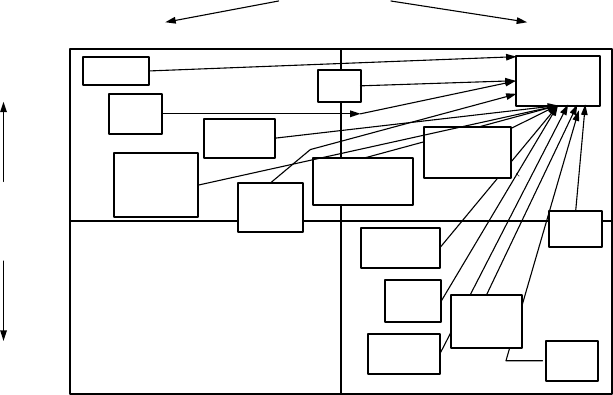
568 CHAPTER 7. INNOVATION AND FUTURE TRENDS
Consider at ion for use ?/
Appr oach
Blue skies Practical
Quest for
under -
st anding?
Knowledge of
fundamentals
Empirical
heuristic
Target status
of magnetic
separation
OGMS
FHS
Wet
HGMS
Dry
HGMS
Low temperature
superconducting
MS
LIMS
WHIMS
Permanent
magnet HIMS
Large
particle
ECS
Biomedical
MS
Flocculation of
ferromagnetic
materials
Flocculation
of weakly
magnetic
materials
Demagneti-
zation
Magnetic
tagging
Figure 7.12: The current status of magnetic separation technology (adapted
from Svoboda [S97]).
Presently, the magnetic techniques of manipulation of matter stand at a
crossroads. The dominant drivers of the early 21st century dier markedly from
those of the late 20th. The priorities of nuclear power, defence and beneficiation
of mineral resources by brute force have been replaced by those associated with
economic growth, discovery of new materials, environmental and knowledge
management and health care. Processes and products from the last century
cannot, therefore, meet the criteria of the 21st century and a new approach will
have to be developed.
7.5.1 Mineral processing
The minerals industry faces problems of declining grades of ores, increasing pro-
portions of deleterious impurities and a need to reduce the particle size in order
to liberate the valuable components. New technologies capable of meeting these
challenges have to be designed for environmental and sustainability reasons.
Magnetic separation, unlike many other technologies of mineral treatment,
can operate in a dry mode. It can perform successfully in arid and arctic regions
and even in extraterrestrial conditions. Problems of water consumption and
e"uent disposal can thus be largely eliminated. Using sophisticated magnet
design or advanced permanent magnet materials, the energy consumption can
be reduced significantly. In addition to lower operating costs, reduction of waste
heat, CO
2
and other emissions will be, therefore, achieved.
7.5. WHAT THE FUTURE HOLDS? 569
In contrast to conventional flotation and flocculation, magnetic separation
does not require chemicals that are responsible for steadily increasing operating
costs and environmental concerns. Similarly, the use of heavy liquids, usually
toxic and costly to acquire and to dispose of, in density separation and coal
preparation, can be eliminated by using magnetism-based techniques.
7.5.2 Biomedical applications
There are three main areas in the biomedical field in which magnetic techniques
are likely to play a role. The development of magnetic carriers and magnetic
fluids as drug carriers and adsorbents is at the top of the list. Future applica-
tions also include the production of DNA sequences, development of magnetic
a!nity adsorbents for isolation and removal of selected biological compounds,
the identification of unwanted toxic organisms in foodstus, and gene cloning.
Drug delivery and the localization of magnetic fluids in target areas will benefit
from new developments of powerful permanent magnet materials.
Although magnetic separation is the most common approach to exploit mag-
netic properties in biosciences, the design of existing commercially available
separators is still based more on a trial-and-error approach than on specialized
knowledge of the fundamentals of magnetism. Future magnetic separation sys-
tems will have to be able to discriminate between targets precisely, will have to
be selective and will be required to leave targets functionally unharmed.
7.5.3 Recycling and waste processing
The recovery of materials from solid waste is technically, and in particular eco-
nomically, complicated. Nevertheless, beneficial uses for stockpiled by-products
are being found, and recycling is experiencing increasing emphasis. While the
process design from the environmental point of view is based on short-term
thinking, sustainability requires a longer view, perhaps 50 years into the future.
It is a tough problem, in which recycling and waste treatment, in addition to
renewability, dematerialization and product life extension, is an important part
of the scenario.
The potential for improved success in the recovery of materials from solid
waste increased considerably with the availability of eddy-current separators for
small particles. The high intrinsic value of non-ferrous metals will inevitably
lead to further improvements in the separation of fine and very fine particles of
non-ferrous metals. This development, combined with availability of even more
powerful permanent magnets that would allow the increase in the magnetic field
strength in eddy-current separators, will extend the range of applicability of this
technique and its viability [V11].
Magnetic carrier and tagging technology allow for rapid and selective sep-
arations of colloidal non-magnetic mineral particles and macromolecules using
magnetic means. To date, this technology has been associated with small-scale
high-value medical and analytical applications. However, with the development
of new inexpensive magnetic support particles and genetic advances in mass
